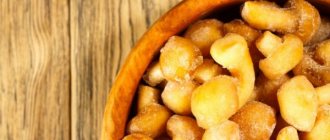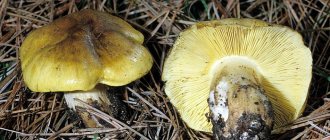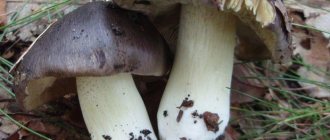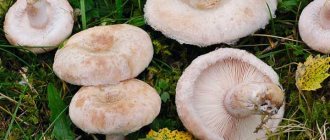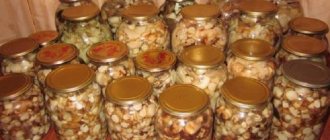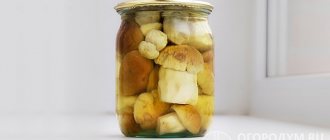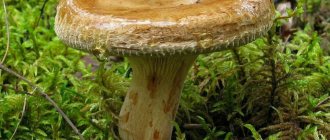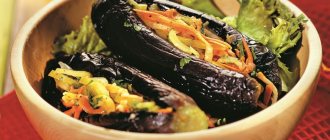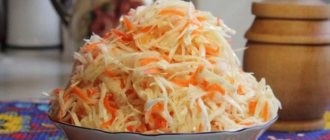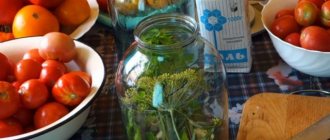Dear readers, during the forest harvest season I decided to return to mushrooms once again. Recently I shared recipes and told how to pickle mushrooms for the winter. See these recipes on the website. Today we will talk about another storage method - pickling mushrooms for the winter.
Pickling mushrooms can be varied. And not only salt and soda, but also various spices, herbs, sugar, onions and other ingredients can participate in the process of preparing forest delicacies for storage. They will certainly add their own flavor notes and give the dish a special zest.
Let's begin...
- How to properly sterilize jars for pickling and storage
- Salting mushrooms in a cold way - butter
- Dry salted saffron milk caps
- Salting boletus mushrooms for the winter, recipe for 1 liter of water
- Recipe for pickling assorted mushrooms
- Quick and easy cold salting of mushroom waxes (milk mushrooms)
- Hot-salted boletuses for the winter
How to properly sterilize jars for pickling and storage
I told you how to properly sterilize jars for sealing for the winter here; in this case, any of the described methods is suitable: under steam, in the oven, in the microwave. You can pickle mushrooms in a regular saucepan or in a barrel, washing them thoroughly. The main difference between jars and a pan (barrel) will be only that in the latter option you will have to eat the mushrooms within one or one and a half months, depending on the recipe. You can store the product in sealed jars until the new harvest season, that is, for a whole year.
What you need to know when going into the forest
To prevent a trip to the forest from being in vain, you need to know the simple rules for collecting mushrooms:
- Collect only known specimens.
- Place young and worm-free ones in the basket.
- In order for the mycelium to produce a new harvest, tubular mushrooms are twisted out, and lamellar mushrooms are cut off with a sharp knife.
- They do not grow in windbreaks or tall grass.
- Place only in baskets, as they quickly deteriorate in bags, plastic or metal buckets.
Every mushroom picker knows that mushrooms are collected from spring to autumn. But autumn ones are more popular, since they can be prepared for future use: pickled, dried and salted. Pickling is an ideal way to preserve forest fruits for a long time.
Suitable species
Almost all types of mushrooms that grow in the forest can be salted. You can salt:
- Honey mushrooms.
- Champignon.
- Gladyshi.
- Podoreshniks (also known as plantains, seryanki, serushki).
- Valui.
- Russula.
- Chanterelles.
- Belyanki.
- Saffron milk caps.
- Loaders (blackening, white, black and dry).
- Yellow milk mushrooms (scrapers, yellow waves).
- Black milk mushrooms (nigella).
- Milk mushrooms.
- Butter.
- Moss mushrooms (Polish, green, red and variegated mushrooms).
- Boletuses.
- Boletus mushrooms.
- White mushrooms.
Tubular mushrooms are considered the best for pickling. The category of the most delicious salted mushrooms includes lacticaria. Tubular mushrooms are incredibly tasty when pickled, but only strong and young ones are used for pickling, otherwise during the cooking process the cap will become tasteless and flabby, and the specific crunch will be lost.
Pickling rules
All edible mushrooms are suitable for pickling, both tubular and lamellar. The main thing is that these are strong young specimens without signs of a wormhole. Before salting, they are washed, and those that contain bitterness are soaked (volnushki, milk mushrooms, bitter mushrooms and valui).
There are several methods of pickling at home:
- cold method with pre-soaking;
- cold method without soaking;
- hot method.
Cold method with soaking
The usual method, which is suitable for all mushrooms that contain bitterness. They are washed and cleaned of contamination. Then fill with salted water (add ½ teaspoon of salt per liter of water). To quickly get rid of bitterness, the water must be changed several times a day.
Soaking time:
- milk mushrooms – 5 days;
- valui – week;
- waves - 2 days.
After soaking, the fruits are cleaned again and placed caps down in a clean container. Each layer is salted. Horseradish leaves, bay leaves, dill, currant, cherry and oak leaves, as well as pepper and cloves to taste are placed on the bottom of the container and on top.
The prepared mushrooms are covered with clean gauze, a disk and a press is installed. After a short time, a brine appears in which the mushrooms will be salted.
You don’t have to add spices and herbs to the milk mushrooms.
Cold method without soaking
The mushrooms are cleaned of soil and dirt, washed thoroughly and placed with their caps down in layers. Each layer is salted. To add flavor, you can add horseradish leaf, dill, allspice and black pepper, oak and currant leaves.
Readiness dates for some mushrooms:
- saffron milk caps - a week;
- milk mushrooms - month;
- valui – 2 months;
- waves - 40 days.
The best container for pickling is an oak barrel. After complete filling, the mushrooms are covered with clean gauze, a wooden disk and a press are installed. If the brine has not formed, it is necessary to select a larger size bend.
Hot salting
Accelerated method. Most specimens can be tasted within a few weeks. Mushrooms with bitterness are pre-boiled in salted water for about half an hour. Milk mushrooms - for 5 minutes.
Russulas, champignons and mushrooms do not need cooking; they are doused with boiling water and kept in it for about half an hour. After the preparatory stage, the mushrooms are pickled, as with the cold method.
The hot method is very popular because it does not require much time and effort.
Milk mushrooms in jars for the winter
Salted milk mushrooms are one of the most famous dishes of Russian cuisine. True, you will have to try hard to prepare them - spend time and effort. But all the efforts will pay off handsomely.
Ingredients:
- Milk mushrooms – 10 kg.
- Salt – 0.5 kg.
Algorithm of actions:
- Select the best mushrooms - without worms and wormholes, not old.
- Rinse thoroughly, you can use a soft brush.
- The next stage is soaking; you can’t do without it, since milk mushrooms (both white and black) have a bitter taste. Fill a large container (glass or enamel) with water and place the mushrooms in it. Cover the top with a lid so that the mushrooms are completely covered with water. For several days, in the morning and evening, the water needs to be changed and the mushrooms washed.
- The longest stage is over, then everything is primitively simple. You need to choose a container for salting; again, it should be glass, enameled.
- Place mushrooms caps down. Sprinkle with salt. Then the next layer. Add salt. Do this until you run out of ingredients.
- Cover the milk mushrooms with gauze or clean cotton cloth. On top is a wooden circle or lid, bending.
- Keep in a cool place.
The mushrooms will be ready after 2 days; you can put them in small containers and pour vegetable oil on top. Put it in the cold, dreaming of a quick tasting.
Storing salted mushrooms
You can store workpieces only in a cool, ventilated room. The ideal temperature for storage is 6 degrees. It should not fall below the 0 mark, since at sub-zero temperatures the mushrooms crumble and lose their taste. If it is high, they sour and become unsuitable for food.
When salting, you need to monitor the brine. If it has evaporated, add boiled salted water.
If mold appears, the circle and gauze are washed and scalded with boiling water.
Salted mushrooms - proven recipes
How to pickle mushrooms depends on the variety, since each has its own characteristics and taste. To get a tasty preparation, you need to learn how to salt them correctly. For any recipe there are general recommendations:
- It is advisable to salt only the caps.
- It is better to salt pork, honey mushrooms and morels using the hot method.
- To remove severe contamination, mushrooms are soaked in saline solution.
- To lighten fruits during hot pickling, add 1 tsp. lemon juice.
- Oak barrels are the best container for pickling; aluminum buckets are not suitable.
- In order not to interrupt the taste of milk mushrooms, spices and herbs are not added.
- Before closing, jars must be clean, or preferably sterilized.
To ensure that the mushrooms retain their forest aroma, you can put heather or spruce branches between the layers.
What mushrooms are salted?
Having collected baskets of mushrooms, people ask themselves the question: which mushrooms are best to pickle for the winter, and which ones are used in everyday dishes? And we have answers to this question:
- Of all the lamellar mushrooms, the ones that are best suited for pickling are: milk mushrooms, sweet mushrooms, autumn mushrooms and champignons, saffron milk caps, serushki, russula, and chanterelles.
- From the tubular category, the following are pickled: porcini mushrooms, boletus mushrooms, boletus mushrooms, boletus mushrooms and boletus mushrooms.
- The favorite when it comes to the taste properties that mushrooms acquire after pickling are milk mushrooms. This type, although it requires long-term cooking and soaking, is ideal for pickling; milk mushrooms also have very valuable properties contained inside.
Honey mushrooms
Honey mushrooms are agaric mushrooms that grow in large, close families on stumps and trees.
Many mushroom pickers confuse edible and false honey mushrooms. How to distinguish them?
Autumn honey fungus | Appears in August and grows until the first frost. The mushroom cap is round, copper-colored with small scales. Young specimens have a thin film under the cap. The plates are light, the stem is thin and elongated, the pulp is coffee-colored |
False honey agaric | Grows in families on birch stumps. False honey fungus is similar to an edible mushroom, but has a rounded flat cap of a dirty lemon color. The plates are greenish-dirty in color. When a leg is broken, colored milky juice is released. |
Hot salting method
Ingredients:
- honey mushrooms – 3 kilograms;
- salt – 9 tbsp. l. ;
- bay leaf – 7 pieces;
- pepper, bay leaf, horseradish, currant, cherry and oak leaves - to taste;
- onion, dill - 60 grams each.
Preparation:
Wash the mushrooms, separate the stems from the caps and boil for half an hour in salted water. When cooked, they begin to darken and to return the original color, you can add lemon juice to the water.
Place the mushrooms in a colander to remove the liquid. After cooling, we proceed to salting.
Place the spices in the prepared container, and then the legs and caps.
We salt each layer, cover the top one with horseradish leaves and clean gauze. We install the wooden disk and the bend.
Leave to pickle for 2-3 weeks.
Salted mushrooms in cucumber brine
Honey mushrooms cooked in brine are very aromatic and crispy.
Products for 1 kg of mushrooms:
- cucumber pickle - half a liter;
- salt – 1 tbsp. l. with a slide;
- bay leaf and dill - 1 piece each;
- pepper, cloves - to taste.
Preparation:
Wash the mushrooms and place them in a saucepan. Fill with salted water (use 10 grams of salt per 1 liter). Bring to a boil, drain all the liquid and wash the mushrooms.
Place them in cold water and cook for about half an hour. Next, put it in a colander to get rid of the water.
Place spices and cooled mushrooms on the bottom of the pickling container. Sprinkle each layer with salt and fill with cucumber pickle. We put pressure on it and put it away for a week in a cool place.
After 40 days you can make the first test.
A quick way to pickle honey mushrooms
This method is simple and easy to perform.
Ingredients for 1 kg of honey mushrooms:
- white salad onion – 1 head;
- cumin – 1 tbsp. l. ;
- bay leaf, dill, pepper - to taste;
- cloves - 2 pieces;
- salt – 2 tbsp. l. without slide;
- garlic – 4 cloves.
Cooking method:
We fill the washed honey mushrooms with water, to which cumin, bay leaves, salt and an onion wrapped in gauze have been added.
After the water boils, reduce the heat and leave to simmer for about half an hour, remembering to skim off the foam.
Place the boiled mushrooms in a colander to remove the liquid.
Place garlic, dill, pepper, cloves and bay leaf into the prepared jar. You can also add cherry and currant.
We put the honey mushrooms into jars and fill them with boiling brine up to the shoulders. Roll up the lids and leave for a week to salt.
Fried mushrooms for the winter in jars
One of the ways to prepare mushrooms for the winter, oddly enough, suggests frying them first and then rolling them up. Those who have tasted this dish say that it is very tasty and does not require any additional culinary processing.
It can be eaten immediately (if the mushrooms were fried in vegetable oil), or heated (if ghee was used). Chanterelles, which do not lose their shape and look very appetizing, are best suited for this method of preparation.
Ingredients:
- Chanterelles
- Salt.
- Pepper.
- Melted butter.
Algorithm:
- The process of harvesting mushrooms begins according to a single scenario - the collected chanterelles need to be sorted out, and this must be done especially carefully. Due to the special structure of the cap, these mushrooms manage to “catch” a lot of forest debris, needles and leaves.
- Then rinse the mushrooms to remove invisible sand and dust. Small mushrooms are rolled up whole, large ones can be cut or broken.
- Place mushrooms in cold water in a large saucepan. Boil. Boil for 5 minutes. Send to a colander.
- Melt butter in a large frying pan. Place chanterelles in a frying pan with oil.
- Now you need to fry until done, the process will take from 40 to 50 minutes. At the very end add a little salt and pepper. You can experiment - squeeze a few cloves of garlic through a press. Then the dish will acquire a pleasant garlic aroma.
- Sterilize containers and lids too.
- Place the mushrooms very tightly. Pour in the oil in which they were fried. Cork.
Send to a cold place, the winter holidays will be very fun and bright, because the main decoration of the festive table will be sunny chanterelles!
Milk mushrooms
Milk mushroom is a favorite of many mushroom pickers. There are a considerable number of species in nature, but mushroom pickers prefer white and black ones.
White milk mushrooms belong to the first category, have a hollow stem and a funnel-shaped cap of milky white color. After salting, they are very tasty and aromatic, acquiring a bluish tint.
Black ones grow until frost. The hat is painted black and green, so in common people they are called gypsies or nigellas.
Salted black milk mushrooms
Ingredients for 1 kg of milk mushrooms:
- refined oil;
- water;
- dill;
- garlic – 5 cloves;
- salt – 2.5 tbsp. l.
Cooking method:
Add oil to the water and add the washed mushrooms. Boil for 7 minutes, place in a colander to remove liquid.
Transfer the mushrooms to a wide container, add dill, chopped garlic, and salt. Mix everything, cover with a towel and set up a press to obtain brine.
After 12 hours, mix again and leave under pressure for 12 hours.
Place the mushrooms in a jar, compact them, add dill and fill with brine so that they are completely covered.
Seal the jar with a lid and put it in the refrigerator for salting. After 30 days you can make the first test.
Cold salted milk mushrooms
We take milk mushrooms into a bucket:
- salt – 2 cups;
- pepper and bay leaf - per package;
- blackcurrant leaves, horseradish and dill umbrellas - to taste;
- garlic - 1 head.
Cooking method:
The washed milk mushrooms are placed with the plates up on dill, currant and horseradish leaves. Large specimens are divided into several parts.
Each layer is salted and bay leaf, dill, chopped garlic and pepper are added. The topmost layer is covered with horseradish leaves and dill. Cover with gauze, install a disk and press to obtain brine.
After the juice appears, the mushrooms are removed for a week in a cool room. After a week, they are placed in jars, adding brine and sealing. Store in the refrigerator.
Hot salted milk mushrooms
For 1 kg of milk mushrooms you will need:
- laurel;
- garlic – 3-5 cloves;
- dill and currant leaves;
- horseradish root;
- salt.
Cooking method:
Remove the stems from washed mushrooms.
Prepare brine at the rate of 2-3 tbsp. l. salt per liter of water. Dip the milk mushrooms into it and boil for half an hour, constantly removing the foam. After 30 minutes, drain the mushrooms into a colander and rinse under the tap.
Place spices and mushroom caps on the bottom of the prepared container. We salt each layer.
Cover the top layer with a towel and install the press. After 2 days, after the brine has formed, remove the container to a cool room. After a month you can do the first test.
Boletus mushrooms in jars for the winter - step-by-step photo recipe
In the photo recipe, the amount of herbs and spices can be determined according to taste. The only exception is vinegar; this ingredient must be taken in certain proportions.
Your rating: (
1 ratings, average: 5.00 out of 5)
Cooking time: 4 hours 0 minutes
Quantity: 3 servings
Volnushki
Volnushka belongs to the Syroezhkov family. In young specimens the cap is convex, but with age it becomes flat with a deep depression in the center. The leg is strong and hard, pale pink in color.
When the plate is broken, abundant snow-white milky juice is released. The flesh of the mushroom is light, the taste is sharp and bitter.
Cold salting of volushki
For salting you will need:
- wavelets - 7 kilograms;
- salt – 200 grams;
- lemon juice – 1 tsp. ;
- dill and caraway seeds;
- cabbage leaf – 1-3 (across the width of the barrel).
Cooking method:
Soak clean mushrooms in salted, acidified water for 3 days, refreshing it periodically.
We lay the waves in layers with the plates facing up. Mix salt with cumin and dill. Salt each layer with this mixture. We cover the top one with cabbage leaves, install a wooden disk and place a weight.
We put the container in a cool room for several months. Before serving, the volushki must be soaked.
The same method can be used to pickle russula and champignons.
Oyster mushrooms
Oyster mushrooms are lamellar mushrooms from the Oyster family. The cap is shiny, sometimes with a coating of mycelium. The color can be either gray or ash-violet. The leg is dense and short.
Mushrooms have an unusual taste and a faint aroma.
Salted oyster mushrooms hot and cold
Ingredients:
- oyster mushrooms – half a kilo;
- water – 2 liters;
- salt – 3 tbsp. l.;
- pepper and bay leaf - to taste;
- garlic – 3 cloves;
- granulated sugar – 1 tbsp. l.
Cooking method:
Hot method. We separate the hats from the legs. We divide large ones into parts and wash them.
Boil water, add all the ingredients, add the mushrooms and boil for 10 minutes, remembering to remove the foam.
Transfer the cooled fruits into the prepared jars, add the garlic and close the lids tightly. A day later we make the first test. Store the finished product in the refrigerator.
Cold way. For 2 kg of mushrooms we take 200 grams of salt.
Place spices, salt and mushrooms in layers at the bottom of the container. We salt each layer. Cover the top one with a clean towel and apply pressure. You can taste the dish in a week.
Preparing mushrooms for pickling
Salting is a unique harvesting method suitable for all edible and conditionally edible varieties. The most interesting thing is that the technology of pickling is always the same, but the preparatory steps have their own nuances: most often edible mushrooms are salted in winter without any preparatory treatments (often without spices), and conditionally edible mushrooms are first soaked or boiled, changing the water several times so that all the bitterness and pungent taste disappeared.
In most conditionally edible mushrooms, the lower surface of the cap is lamellar and fragile, so only young, strong samples are taken for processing.
The assembled collection should not be left for more than 3-4 hours. Mushrooms must be used immediately for cooking or processing. First of all, they must be sorted and cleaned.
Many mushroom pickers recommend limiting yourself to dry cleaning or cutting off dirt from the stems and removing debris that sticks to the caps with a soft brush or sponge. In particular, this is true for options intended for drying. If there is a large amount of sand, the mushroom must be quickly soaked in cold water, then washed and boiled in brine.
For cooking, prepare brine with 1 tbsp. salt per 1 liter of water. Place the mushrooms in boiling water for 10-15 minutes. During boiling, sand will settle to the bottom of the pan, and plant debris (needles, grass, leaves) will rise to the surface combined with foam.
Because of this, the mushrooms are not actively stirred, but only submerged with a spoon and the foam is removed. Then they need to be carefully placed in a colander using a slotted spoon, under no circumstances pouring them out of the pan, and rinsed with running water.
Saffron milk caps
Ryzhiki are considered noble royal mushrooms. They grow in pine forests on sandy soil.
The mushroom cap is funnel-shaped and orange or brick-colored. The pulp is fleshy, when broken, it acquires a red and then green tint, and releases abundant bright orange milky juice.
Cold pickling of saffron milk caps
A common method of pickling, as it is easy to perform, and the preparations can be stored all winter.
For 2 kg of saffron milk caps you will need:
- salt – 3 tbsp. l. ;
- garlic – ½ head;
- currant leaves, allspice - to taste;
- bay leaf - 1 package.
Cooking method:
We clean the saffron milk caps, wash them and dry them.
Place spices and a little salt into the prepared container. We stack the mushrooms with their caps up, salting each layer, cover them with gauze and install the press.
After 6 hours they will settle and it is recommended to add a new batch for compaction.
Ryzhiki are salted at a temperature of 20 degrees. Every third day we wash the gauze and scald it with boiling water. It is also necessary to ensure that the mushrooms are constantly in the brine.
After 2 weeks, put the mushrooms in jars, add brine and put them in the refrigerator. Cooked saffron milk caps in this way can be stored for 2 years or more.
Expanded list of edible mushrooms with photos
This slideshow contains all the mushrooms, including those not mentioned in the article:
September is surprisingly rich in mushrooms: the baskets still contain solid white, bright aspen boletuses and delicious boletus boletuses, and the most abundant and productive mushrooms – autumn honey mushrooms – are already appearing on the stumps. Experienced housewives know that not everything is suitable for pickling: this selection from the book by A. Matantsev, S. Matantseva “The Great Encyclopedia of Mushroom Picking: Collection, Storage, Processing” details the best candidates for barrels, tubs and jars.
September is surprisingly rich in mushrooms
Hiking in a fabulous autumn forest warms the soul and creates a wonderful mood that remains long after the walk, so many people go mushroom hunting with their entire families. So what to put in the basket first, how to recognize royal mushrooms for pickling among many others?
Let us remind you that you can see the classification of the nutritional value of mushrooms in the publication Beware of Mushrooms! Golden rules of “quiet hunting”.
